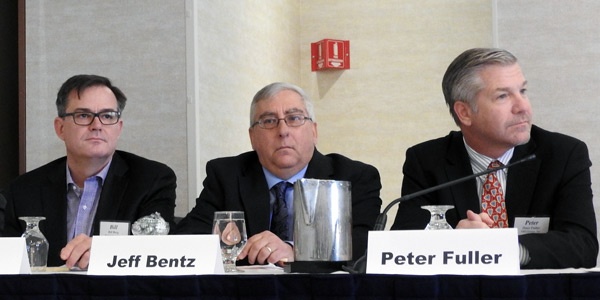By William Opalka
WESTBOROUGH, Mass. — The challenge of preserving competitive markets while decarbonizing the New England economy was much on the minds of attendees at the Northeast Energy and Commerce Association’s 15th Power Markets Conference last week.
Some stakeholders fear New England states’ plans to procure up to 2,000 MW of renewable capacity could suppress prices in ISO-NE’s Forward Capacity Auctions. Those fears have receded somewhat, as the states are currently in negotiations for no more than 460 MW. (See New England States Move Toward Renewables Contracts.)
“The short-term problem isn’t as big as what was expected,” Jeff Bentz, director of analysis at the New England States Committee on Electricity, said during a panel discussion on the New England Power Pool’s Integrating Markets and Public Policy (IMAPP) process. “That level is pretty small and could enter in FCA 12 [2021/22] but probably won’t enter until FCA 13 [2022/23].”
Another panelist, Peter Fuller, vice president of market and regulatory affairs at NRG Energy, described his company’s proposed two-step auction to accommodate state policy resources while maintaining efficient pricing for merchant generators.
The first auction would reflect the market without the effect of subsidized resources. which would be paid to all generating resources clearing in the first step. A second, lower price including the subsidized capacity would be paid to the generating resources that are subsidized by state policy.
All resources cleared in both steps would receive a capacity obligation, but these obligations would be pro-rated to ensure that the total quantity of generation purchased is no greater than the status quo, ‘merchant’ outcome. NRG says this would ensure that the cost impact of the states’ policy actions is shared among all market suppliers equitably.
“While NRG supports including state policy-subsidized generating resources in the markets, t wholesale sellers and the private investors in the market should not have to shoulder the entire burden of all of the state policy objectives,” Fuller said. “And effectively that’s the world we’re in right now. The [ISO-NE] renewable technology resource exemption, while limited, does create a price-suppression effect and potentially puts the full cost of adding those resources on the backs of all resources in the markets.”
Bill Berg, vice president of wholesale market development at Exelon, said the IMAPP meetings instead need to determine what subsidized resources are able to bid into the FCA and which aren’t. An estimated 8.7 GW of nameplate clean energy generation capacity will be needed to meet the states’ 2030 goals.
“We’re talking about 8.7 GW of subsidized capacity. Think about the angst that 200 MW has caused. Think about trying to design a market that puts both objectives, allowing the states to do what they want and protect reliability and the market, when you’re dealing with an 8.7-GW spread, which is 25% of the [FCA] market,” he said.
Pallas LeeVanSchaick, vice president of Potomac Economics, the ISO-NE External Market Monitor, said there are inherent risks in the adoption of out-of-market contracts intended to achieve public policy objectives.
“We’re going to get to the point that contracts with individual resources may not pass on costs in the short term, except that they’re able to fund those priorities through lower wholesale prices,” he said. “Maybe in the short term we don’t see higher rates to consumers, but in the long term, I bet we will see legacy costs that go on long after the impacts on the lower wholesale prices end. We’re going to notice over time that these are not in the interests of consumers.”
On a panel on the opportunities presented by energy storage, Ian Springsteel, director of U.S. regulatory strategy for National Grid, likened the industry to how consumers might have reacted to a smart phone a decade ago. It has seemingly unlimited potential, but the industry and public aren’t quite sure what the device can do or how to integrate it into daily practices.
“We’re in the same place with storage. We have an inkling of what it can do as one of many tools in the energy market or the distribution system. But to integrate it into all the rules and operational framework, to fully use this technology, we’re at the beginning of that process,” he said.
Christopher Parent, director of market development at ISO-NE, said the RTO is comfortable with storage, having had decades of experience with pumped hydro in New England. ISO-NE currently has about 90 MW of storage in its interconnection queue. The queue has a total of 10,000 MW of resources, many from flexible fast-start gas generators.
“When we look at our 2025 [projections], we’re looking at 4,400 MW of wind and about 3,300 MW of solar on the system,” Parent said. “That creates a lot of variability on the system that shows annual summer peaks of about 25,000 to 28,000 MW. That’s going to create a need for a lot of flexible resources on the system, be it storage or whatever technologies materialize in the coming years. The key thing in the market is to send the right price signals so we get the response we need.”
— William Opalka







